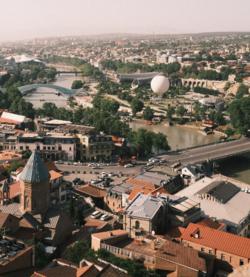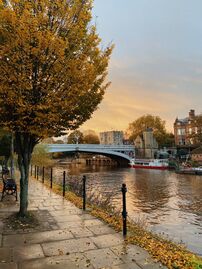Zwanport
Zwanport, capital and the biggest city of Pelz is located around Zilverstroom River. The river cuts the city in two halves, creating a great scenery in the central part of the city. Zwanport has been always the hotspot for the cultural and religious movements happened Pelz. Zwanport has the population of 2.1 million and is known to be one of the cleanest cities in the region despite of the population. Zwanport was the first city to ban automobiles in Pelz which massively reduced the carbon footprint of the nation.
Zwanport | |
|---|---|
Capital City | |
| Zwanport | |
 | |
 | |
| Named for | The national animal of Pelz, Swan. |
| Area | |
| • Land | 287.3 km2 (110.9 sq mi) |
| Elevation | 2 m (7 ft) |
| Population | |
| • Total | 2,195,788 |
History
The first appearance of a settlement called Zwanport was recorded all the way in the year 311. Evidence suggests that the settlers made their way through the Kraslyng Ocean and formed their settlement near the coast. The village later evolved to be a coastal port, promoting trade with other settlements in the region.
Zwanport has maintained its tradelines through the sea with other settlements even to this day. It's been one of the important trade routes leading to the Pezlain territory. It also has served the Pelzian economy rather well in the past by promoting a sufficient way of exporting to other nations that Pelz does not share a ground border with.
Throughout history, Zwanport has been the most important cultural capital of the country, serving many artists of various kinds as a safe homeland to choose. Notable poets, painters, and writers of Pelzian society chose Zwanport as their city of choice since it has usually been safe in different stages of history in Pelz, both in the pre-Novemberism era and after that.
Demographics
The city of Zwanport is home to more than 2,100,000 Pezlains (last updated in 2019). The Latest research on the population and data from the field calculation suggests that more than 97% of this population is of pure Pelzian blood. This means the capital, as much as the country itself, is almost untouched by any migration.
The city is currently the most populated city in Pelz, and it serves as both the country's political and cultural capital.
Economy and Infrastructure
Zwanport is the economic center of Pelz, with the population being among the highest-earning individuals in the country. This would be due to the number of private and public corporations available in Pelz. Generally increasing the employment opportunities available for people. Calculations done in 2021, showed that a great number of city's population is employed by government institutes and about 40%of the rest are hired by private corporations.
The city is famous for being one of the first cities in Pelz for regulating a wide ban on automobiles on 1965. This later resulted in the city to be heavily dependant on public transportations. Today in Zwanport you can almost access any point in the city using freely available public transportation. On 1971, Mayor of Zwanport announced a 450 Million budget for public transportation improvements in Zwanport. This reduced the average waiting time for buses and subways across the city by five minutes. On 2021, Zwanport announced for the first time in the city's history, you can access the subway from any station only with the waiting time of 30 seconds. This applied to 45 stations that have been established all across the city.

